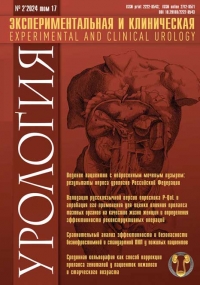Physiological role and clinical significance of sex gormone binding globulin in men DOI: doi.org/10.29188/2222-8543-2024-17-2-45-51
- Ryzhkov A.I. – PhD, assistant professor of the department of urology with nephrology Federal State Budgetary Educational Institution of Higher Education «Yaroslavl State Medical University», urologist LLC «Mother and Child Yaroslavl»; Yaroslavl, Russia; RSCI Author ID 715193, https://orcid.org/0000-0001-7919-9830
- Sokolova S.Yu. – urologist LLC «Mother and Child Yaroslavl»; Yaroslavl, Russia; https://orcid.org/0000-0002-3673-0713
- Shormanov I.S. – Dr. Sci., Professor, Head of the Department of Urology with Nephrology of the Federal State Budgetary Institution of Higher Education «Yaroslavl State Medical University»; Yaroslavl, Russia; RSCI Author ID 584874, https://orcid.org/0000-0002-2062-0421
 8
8 The main physiological functions of globulin that binds sex hormones (SHBG) in the male body are the transport of sex steroids in hydrophilic blood and the creation of a buffer system that smooths out fluctuations in the concentration of free testosterone. In addition, sex hormone binding globulin can limit the biological activity of sex steroids by reducing the concentration of the free fraction of the hormone, but only when the hypothalamicpituitary-testicular axis is non-functioning or inadequately functioning. If the negative feedback mechanism works correctly, the concentration of SHBG will determine the level of total testosterone, but will not affect the free fraction and, accordingly, the biological activity of sex steroids. It is likely that SHBG has other functions, as indicated by the presence of SHBG receptors in some tissues and the mechanism of SHBG transport into the cell through endocytosis, but the physiological role of these processes is currently unclear and requires further study. From a practical point of view, determining the level of SHBG is necessary primarily to calculate the level of free testosterone, since accurate methods for directly measuring free testosterone are not available in clinical practice. Diagnosing hypogonadism based solely on total testosterone levels is associated with the risk of overdiagnosis, since the concentration of SHBG in the blood can have a significant effect on total testosterone levels without changing free testosterone levels. The use of SHBG as a biomarker for a number of diseases and pathological conditions seems promising. Lower SHBG concentrations are associated with an increased risk of diabetes mellitus, metabolic syndrome, and non-alcoholic fatty liver disease (NAFLD), and higher SHBG concentrations are associated with an increased risk of osteoporosis and fractures in older men. At the same time, the question remains open whether SHBG is just a biomarker or is involved in the pathogenesis of the development of these diseases?
| Attachment | Size |
|---|---|
| Download | 451.4 KB |
















































































